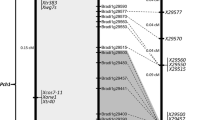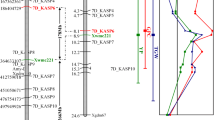Abstract
Introgressions into wheat from related species have been widely used as a source of agronomically beneficial traits. One such example is the introduction of the potent eyespot resistance gene Pch1 from the wild relative Aegilops ventricosa onto chromosome 7DL of wheat. In common with genes carried on many other such introgressions, the use of Pch1 in commercial wheat varieties has been hindered by linkage drag with yield-limiting traits. Attempts to break this linkage have been frustrated by a lack of co-dominant PCR markers suitable for identifying heterozygotes in F2 populations. We developed conserved orthologous sequence (COS) markers, utilising the Brachypodium distachyon (Brachypodium) genome sequence, to provide co-dominant markers in the Pch1 region. These were supplemented with previously developed sequence-tagged site (STS) markers and simple sequence repeat (SSR) markers. Markers were applied to a panel of varieties and to a BC6 F2 population, segregating between wheat and Ae. ventricosa over the distal portion of 7DL, to identify recombinants in the region of Pch1. By exploiting co-linearity between wheat chromosome 7D, Brachypodium chromosome 1, rice chromosome 6 and sorghum chromosome 10, Pch1 was located to an interval between the flanking markers Xwg7S and Xcos7-9. Furthermore candidate gene regions were identified in Brachypodium (364 Kb), rice (178 Kb) and sorghum (315 Kb) as a prelude to the map-based cloning of the gene. In addition, using homoeologue transferable markers, we obtained evidence that the eyespot resistances Pch1 and Pch2 on chromosomes 7D and 7A, respectively, are potentially homoeoloci. It is anticipated that the COS marker methodology could be used for the identification of recombinants in other introgressions into wheat from wild relatives. This would assist the mapping of genes of interest and the breaking of deleterious linkages to enable greater use of these introgressions in commercial varieties.



Similar content being viewed by others
References
Bassam BJ, Caetano-Anolles G, Gresshoff PM (1991) Fast and sensitive silver staining of DNA in polyacrylamide gels. Anal Biochem 196:80–83
Bertin I, Zhu JH, Gale MD (2005) SSCP-SNP in pearl millet: a new marker system for comparative genetics. Theor Appl Genet 110:1467–1472
Bossolini E, Wicker T, Knobel PA, Keller B (2007) Comparison of orthologous loci from small grass genomes Brachypodium and rice: implications for wheat genomics and grass genome annotation. Plant J 49:704–717
Burt C, Hollins TW, Powell N, Nicholson P (2010) Differential seedling resistance to the eyespot pathogens, Oculimacula yallundae and Oculimacula acuformis, conferred by Pch2 in wheat and among accessions of Triticum monococcum. Plant Pathol 59:819–828
Burt C, Hollins TW, Nicholson P (2011) Identification of a QTL conferring seedling and adult plant resistance to eyespot on chromosome 5A of Cappelle Desprez. Theor Appl Genet 122:119–128
Büschges R, Hollricher K, Panstruga R, Simons G, Wolter M, Frijters A, van Daelen R, van der Lee T, Diergaarde P, Groenendijk J, Töpsch S, Vos P, Salamini F, Schulze-Lefert P (1997) The Barley Mlo Gene: a novel control element of plant pathogen resistance. Cell 88:695–705
Chapman N, Burt C, Dong H, Nicholson P (2008) The development of PCR-based markers for the selection of eyespot resistance genes Pch1 and Pch2. Theor Appl Genet 117:425–433
Chapman NH, Burt C, Nicholson P (2009) The identification of candidate genes associated with Pch2 eyespot resistance in wheat using cDNA-AFLP. Theor Appl Genet 118:1045–1057
Chen X-Y, Kim J-Y (2009) Callose synthesis in higher plants. Plant Signal Behav 4:489–492
de la Peña RC, Murray TD, Jones SS (1996) Linkage relations among eyespot resistance gene Pch2, endopeptidase Ep-A1b, and RFLP marker Xpsr121 on chromosome 7A of wheat. Plant Breeding 115:273–275
de la Peña RC, Murray TD, Jones SS (1997) Identification of an RFLP interval containing Pch2 on chromosome 7AL in wheat. Genome 40:249–252
Doussinault G, Delibes A, Sanchezmonge R, Garciaolmedo F (1983) Transfer of a dominant gene for resistance to eyespot disease from a wild grass to hexaploid wheat. Nature 303:698–700
Endo TR, Gill BS (1996) The deletion stocks of common wheat. J Heredity 87:295–307
Feuillet C, Langridge P, Waugh R (2008) Cereal breeding takes a walk on the wild side. Trends Genetics 24:24–32
Fulton TM, Van der Hoeven R, Eannetta NT, Tanksley SD (2002) Identification, analysis, and utilization of conserved ortholog set markers for comparative genomics in higher plants. Plant Cell 14:1457–1467
Garvin DF, McKenzie N, Vogel JP, Mockler TC, Blankenheim ZJ, Wright J, Cheema JJS, Dicks J, Huo NX, Hayden DM, Gu Y, Tobias C, Chang JH, Chu A, Trick M, Michael TP, Bevan MW, Snape JW (2010) An SSR-based genetic linkage map of the model grass Brachypodium distachyon. Genome 53:1–13
Groenewald JZ, Marais AS, Marais GF (2003) Amplified fragment length polymorphism-derived microsatellite sequence linked to the Pch1 and Ep-D1 loci in common wheat. Plant Breeding 122:83–85
Huguet-Robert V, Dedryver F, Röder MS, Korzun V, Abélard P, Tanguy AM, Jaudeau B, Jahier J (2001) Isolation of a chromosomally engineered durum wheat line carrying the Aegilops ventricosa Pch1 gene for resistance to eyespot. Genome 44:345–349
International Brachypodium Initiative (2010) Genome sequencing and analysis of the model grass Brachypodium distachyon. Nature 463:763–768
International Rice Genome Sequencing Project (2005) The map-based sequence of the rice genome. Nature 436:793–800
Jahier J, Tanguy AM, Doussinault G (1989) Analysis of the level of eyespot resistance due to genes transferred to wheat from Aegilops ventricosa. Euphytica 44:55–59
Johnson R (1992) Past, present and future opportunities in breeding for disease resistance, with examples from wheat. Euphytica 63:3–22
Joobeur T, King JJ, Nolin SJ, Thomas CE, Dean RA (2004) The fusarium wilt resistance locus Fom-2 of melon contains a single resistance gene with complex features. Plant J 39:283–297
Jørgensen IH (1992) Discovery, characterization and exploitation of Mlo powdery mildew resistance in barley. Euphytica 63:141–152
King J, Armstead IP, Donnison IS, Harper JA, Roberts LA, Thomas H, Ougham H, Thomas A, Huang L, King IP (2007) Introgression mapping in the grasses. Chromosom Res 15:105–113
Koebner RMD, Miller TE, Snape JW, Law CN (1988) Wheat endopeptidase—genetic-control, polymorphism, intrachromosomal gene location, and alien variation. Genome 30:186–192
Koen E, Labuschagne MT, Viljoen CD (2002) The influence of eyespot resistance genes on baking quality and yield in wheat. J Sci Food Agric 82:1537–1540
Krattinger SG, Lagudah ES, Spielmeyer W, Singh RP, Huerta-Espino J, McFadden H, Bossolini E, Selter LL, Keller B (2009) A putative ABC transporter confers durable resistance to multiple fungal pathogens in wheat. Science 323:1360–1363
Leonard J, Watson C, Carter A, Hansen J, Zemetra R, Santra D, Campbell K, Riera-Lizarazu O (2008) Identification of a candidate gene for the wheat endopeptidase Ep-D1 locus and two other STS markers linked to the eyespot resistance gene Pch1. Theor Appl Genet 116:261–270
Maia N (1967) Obtention de blés tendres résistants au piétin-verse (Cercosporella herpotrichoides) par crôisements interspécifiques blés × Aegilops. Comptes Rendus de l’Académie d’Agriculture de France 53:149–155
Martins-Lopes P, Zhang H, Koebner R (2001) Detection of single nucleotide mutations in wheat using single strand conformation polymorphism gels. Plant Mol Biol Rep 19:159–162
McDonald B (2010) How can we achieve durable disease resistance in agricultural ecosystems? New Phytol 185:3–5
McMillin DE, Allan RE, Roberts DE (1986) Association of an isozyme locus and strawbreaker foot rot resistance derived from Aegilops ventricosa in wheat. Theor Appl Genet 72:743–747
Mena M, Doussinault G, Lopez-Brana I, Aguaded S, Garcia-Olmedo E, Delibes A (1992) Eyespot resistance gene Pch1 in H-93 wheat lines. Evidence of linkage to markers of chromosome group 7 and resolution from the endopeptidase locus Ep-D1b. Theor Appl Genet 83(8):1044–1047
Meyer N, Lind V, Heindorf M, Korzun V, Friedt W, Ordon F (2011) Diagnostic value of molecular markers linked to the eyespot resistance gene Pch1 in wheat. Euphytica 177:267–275
Murray TD, Ye H (1986) Papilla formation and hypersensitivity at penetration sites and resistance to Pseudocercosporella herpotrichoides in winter wheat. Phytopathology 76:737–744
Olmos S, Distelfeld A, Chicaiza O, Schlatter AR, Fahima T, Echenique V, Dubcovsky J (2003) Precise mapping of a locus affecting grain protein content in durum wheat. Theor Appl Genet 107:1243–1251
Ori N, Eshed Y, Paran I, Presting G, Aviv D, Tanksley S, Zamir D, Fluhr R (1997) The I2C family from the wilt disease resistance locus I2 belongs to the nucleotide binding, leucine-rich repeat superfamily of plant resistance genes. Plant Cell 9:521–532
Ouyang S, Zhu W, Hamilton J, Lin H, Campbell M, Childs K, Thibaud-Nissen F, Malek RL, Lee Y, Zheng L, Orvis J, Haas B, Wortman J, Buell CR (2007) The TIGR rice genome annotation resource: improvements and new features. Nucleic Acids Res 35:D883–D887
Paterson AH, Bowers JE, Bruggmann R, Dubchak I, Grimwood J, Gundlach H, Haberer G, Hellsten U, Mitros T, Poliakov A, Schmutz J et al (2009) The Sorghum bicolor genome and the diversification of grasses. Nature 457:551–556
Payne RW, Harding SA, Murray DA, Soutar DM, Baird DB, Glaser AI, Channing IC, Welham SJ, Gilmour AR, Thompson R, Webster R (2009) GenStat® for Windows 12th Edition Introduction. VSN International, Hemel Hempstead
Quraishi UM, Abrouk M, Bolot S, Pont C, Throude M, Guilhot N, Confolent C, Bortolini F, Praud S, Murigneux A, Charmet G, Salse J (2009) Genomics in cereals: from genome-wide conserved orthologous set (COS) sequences to candidate genes for trait dissection. Funct Integr Genomics 9:473–484
Riley R, Chapman V, Kimber G (1959) Genetic control of chromosome pairing in intergeneric hybrids with wheat. Nature 183:1244–1246
Roder MS, Korzun V, Wendehake K, Plaschke J, Tixier MH, Leroy P, Ganal MW (1998) A microsatellite map of wheat. Genetics 149:2007–2023
Santra DK, Watt C, Little L, Kidwell KK, Campbell KG (2006) Comparison of a modified assay method for the endopeptidase marker Ep-D1b with the Sequence Tag Site marker XustSSR2001–7DL for strawbreaker foot rot resistance in wheat. Plant Breeding 125:13–18
Schlegel R, Korzun V (1997) About the origin of 1RS.1BL wheat–rye chromosome translocations from Germany. Plant Breeding 116:537–540
Schneider A, Molnár I, Molnár-Láng M (2008) Utilisation of Aegilops (goatgrass) species to widen the genetic diversity of cultivated wheat. Euphytica 163:1–19
Somers DJ, Isaac P, Edwards K (2004) A high-density microsatellite consensus map for bread wheat (Triticum aestivum L.). Theor Appl Genet 109:1105–1114
Song QJ, Fikcus EW, Cregan PB (2002) Characterization of trinucleotide SSR motifs in wheat. Theor Appl Genet 104:286–293
van Ooijen JW, Maliepaard C (1996) MapQTL version 4.0: Software for the calculation of QTL positions on genetic maps. CPRO-DLO, Wageningen
Van Ooijen JW, Voorips RE (2001) Joinmap 3.0: Software for the calculation of genetic linkage maps. Plant Research International, Netherlands
Vincent A, Ponchet J, Koller J (1952) Recherche de variétés de blés tendres peu sensibles au piétin-verse: résultats préliminaires. Annales de l’Amélioration de Plantes 2:459–472
Voigt CA, Schäfer W, Salomon S (2006) A comprehensive view on organ-specific callose synthesis in wheat (Triticum aestivum L.): glucan synthase-like gene expression, callose synthase activity, callose quantification and deposition. Plant Physiol Biochem 44:242–247
Wang HY, Yang WX, Zhang LR, Meng QF, Liu DQ, Zhang T (2006) Isolation and characterization of resistance gene homology sequence from wheat. J Phytopathol 154:670–675
Worland AJ, Law CN, Hollins TW, Koebner RMD, Giura A (1988) Location of a gene for resistance to eyespot (Pseudocercosporella herpotrichoides) on chromosome 7D of bread wheat. Plant Breeding 101:43–51
Acknowledgments
The authors would like to thank Dr. Simon Griffiths and Michelle Leverington-Waite at the JIC for developing and providing the “Wg” and “Tr” COS markers. The “Wg” COS markers were developed through a grant for the Wheat Genetic Improvement Network (WGIN) from the UK Department of Environment, Food and Rural Affairs (DEFRA). The “Tr” COS markers were developed through a Biotechnology and Biological Sciences Research Council (BBSRC) Tools and Resources award (BBE0235681) to S. Griffiths. We would also like to thank Dr. Peter Jack and Bill Hollins at RAGT Seeds Ltd. for providing the panel of wheat varieties and breeding lines.
Author information
Authors and Affiliations
Corresponding author
Additional information
Communicated by M. Bohn.
Electronic supplementary material
Below is the link to the electronic supplementary material.
Rights and permissions
About this article
Cite this article
Burt, C., Nicholson, P. Exploiting co-linearity among grass species to map the Aegilops ventricosa-derived Pch1 eyespot resistance in wheat and establish its relationship to Pch2 . Theor Appl Genet 123, 1387–1400 (2011). https://doi.org/10.1007/s00122-011-1674-9
Received:
Accepted:
Published:
Issue Date:
DOI: https://doi.org/10.1007/s00122-011-1674-9




